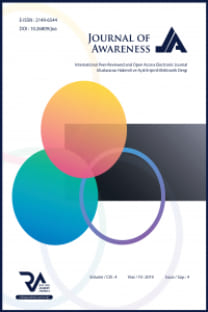MONTAJ VE KOLAJ KAVRAMLARI BAĞLAMINDA 20.YÜZYIL’DA SİNEMA VE RESİM SANATINDA GELİŞEN YENİ BİÇİM ARAYIŞLARI
1839 yılında fotoğrafın icadı ve 1895'de sinema teknolojisinin gelişmesiyle birlikte özellikle resim sanatı, değişim ve bir bakıma gelişim yaşamaya başlamıştır. Bu sayede doğayı taklit etme (mimesis) fikrine olan bağımlılığından kurtulmayı başaran resim sanatı bu görevi fotoğrafa devrederek, kendisine yeni bir yol bulmayı amaçlamıştır. Ressamlar, üretim ve anlatım yöntemlerini gözden geçirmiş ve resmin kendi estetiği üzerine yeni fikirler üretmişlerdir.D. W. Griffith ve George Melies, sinema teknikleri üzerine birçok deney yapmış ve gelişiminde önemli bir rol oynamıştır. Griffith'in anlatımı güçlendirmek adına filmlerinde yaptığı kesmeler daha sonra Sovyet sinemacıları tarafından "montaj" olarak tanımlanan yöntemin temelini oluşturmaktadır.Aynı dönemde Pablo Picasso ve Georges Braque'da resim sanatı adına önemli adımlar atmaktaydılar. Picasso ve Kübizmin diğer temsilcileri nesneleri gözle görüldükleri biçimde resmetme kaygısı taşımamışlardır. Amaçları nesneyi kopya etmek değil onu baştan düzenlemektir. Tualin üzerine yerleştirdikleri resim dışı öğeler ile resmedilen objeyi farklı kavramlarla ilişkilendirdikleri "kolaj" tekniği, resimde yeni bir zaman ve mekan algısı yaratmaktadır.Tarihsel olarak aynı dönemde ortaya çıkmış bu iki kavram, resim ve sinema için bütünün oluşturulmasında izlenecek yöntem ile ilgili benzer çözümler üretmektedirler.Bu bağlamda bu çalışmada literatür ve görsel tarama yöntemleriyle, “montaj” ve “kolaj” kavramlarının dönemin sinema ve resim sanatı üzerindeki etkileri, benzerlik içeren ve ayrışan yönleriyle incelenecektir.
Anahtar Kelimeler:
Sinema, Güzel Sanatlar, Resim, Montaj, Kolaj
NEW FORM QUESTS DEVELOPED ON CINEMA AND PAINTING IN THE CONTEXT OF THE MONTAGE AND COLLAGE CONCEPTS IN 20. CENTURY
With the invention of photography in 1895 and the development of cinematography in 1939, especially the art of painting, have begun to change.Thus, painting escaped from the addictive idea of imitating nature (mimesis) and aimed to find a new way for itself through transferring this task to the photograph.Painters, has revised the methods of expression and production and have produced new ideas on the aesthetics of the painting. D. W. Griffith and George Melies have done many experiments on cinematography and played an important role in the development of the cinema.The cuts, Griffith made in his films to reinforce the narrative form,would have become the basis of the method,which would have been described as "montage" by Soviet cinematographers later on. During the same period,Pablo Picasso and Georges Braque were breaking new grounds in painting.Picasso and other representatives of Cubism have not worry about, describing objects as they see.Their purpose is not to copy the object but to rearrange itfrom scratch.The "collage" technique, which they linked the illustrated object to the different concepts via external items they placed on canvas,, creates a new sense of time and space in the painting. These two concepts, which are emerged in the same periodchronologically, produce similar solutions for the method to be followed in the integration for the painting and the cinema. In this study, effects of the the concepts of "montage" and "collage" on the art of the cinema and the painting of their time will be contextualised with both the similarities and the differences via literature and visual screening methods
- ISSN: 2149-6544
- Başlangıç: 2016
- Yayıncı: Rating Academy
Sayıdaki Diğer Makaleler
MAHALLE ÖĞESİ VE TURGUT CANSEVER PROJELERİ
İlköğretim Görsel Sanatlar Dersi Kapsamında Gerçekleştirilen Araştırmalara İlişkin Bir İnceleme
UZUN METRAJLI 3D DİJİTAL ANİMASYONLARIN ÜRETİM SÜREÇLERİ VE KULLANILAN TEKNİKLER
Batı Trakyalı Türk Öğrencilerin, Okudukları Kitapları Anlama Düzeyleri Açısından Değerlendirilmesi
Esin Yağmur ŞAHİN, Gülnur AYDIN, Abdullah ŞAHİN, Mesout Kalın SALI, Kübra EMRE
Rekreasyon, gündelik yaşam kalitesinde bir marka; “bana iyi geldi”
Jasper Johns’un Eserlerinde Popüler Kültür İmgeleri
Özlem TONGUÇ YAYINTAŞ, Latife Ceyda İRKİN
GENÇLERİN VE YAŞLILARIN YAŞLILIK SÜRECİNE İLİŞKİN GÖRÜŞLERİ: KARŞILAŞTIRMALI BİR ÇALIŞMA
